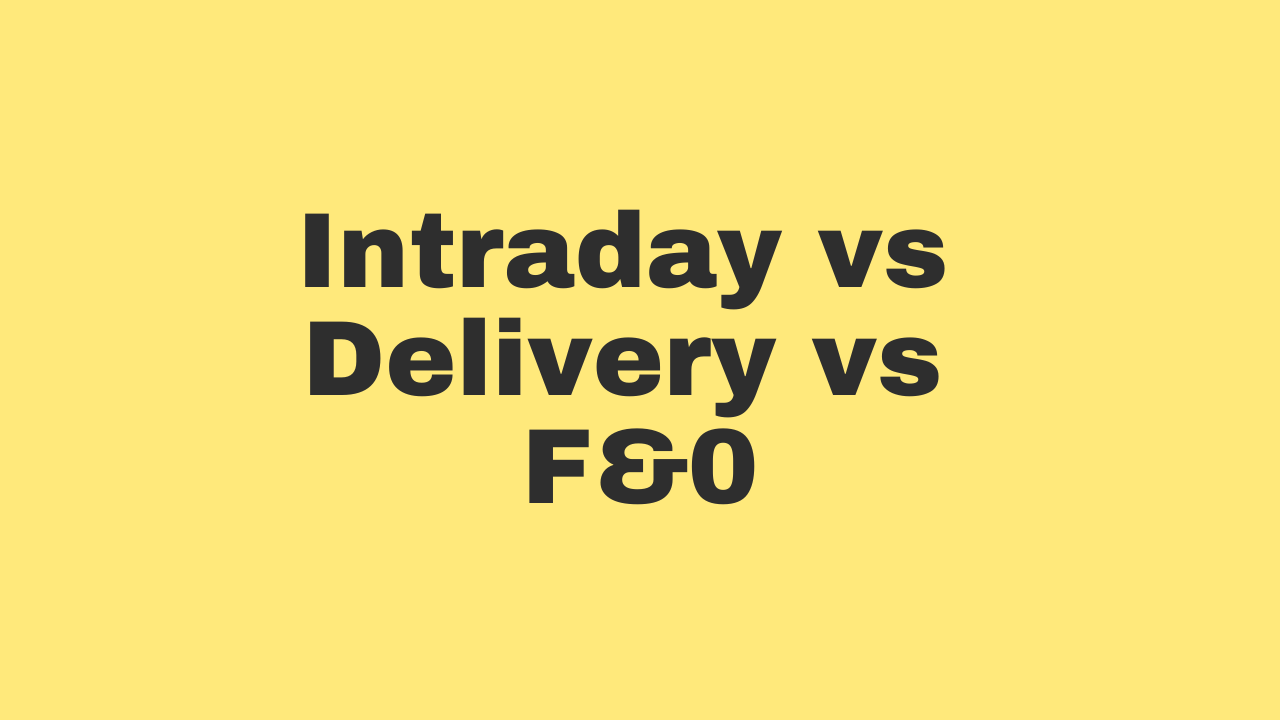Investing and trading in the stock market provide multiple avenues for individuals to grow their wealth. Among the various strategies, Intraday trading, Delivery-based investing, and Futures and Options (F&O) trading stand out as popular choices.
Each of these methods has unique characteristics, risks, and rewards. This article dives deep into the comparison between these three approaches, helping you determine which suits your financial goals and risk appetite.
What Is Intraday Trading?
Intraday trading involves buying and selling stocks within the same trading day. The goal is to capitalize on small price movements in a short timeframe. Positions are squared off by the end of the market hours, ensuring no overnight risk.
Key Features of Intraday Trading
- Short-Term Approach: All trades are completed within a single day.
- Leverage: Brokers often provide leverage to traders, allowing them to trade larger positions with less capital.
- High Risk-High Reward: Small price movements can result in significant profits or losses due to leverage.
- Active Monitoring: Requires constant attention to the market.
What Is Delivery-Based Trading?
Delivery trading refers to the process of buying shares and holding them for a longer period, from days to years. The shares are delivered to the investor’s demat account and can be sold when needed.
Key Features of Delivery-Based Trading
- Long-Term Approach: Ideal for wealth creation over a longer horizon.
- No Leverage: Requires full payment upfront, reducing risks associated with borrowing.
- Stable Returns: Less affected by short-term market volatility.
- Dividends and Benefits: Investors are entitled to dividends, bonuses, and stock splits.
What Is Futures and Options (F&O) Trading?
Futures and Options are derivatives that derive their value from an underlying asset such as stocks, indices, or commodities. These instruments allow traders to speculate on price movements or hedge against potential losses.
Key Features of F&O Trading
- Leverage and Margin: Trades are executed on margin, enabling larger exposure with less capital.
- Hedging Opportunities: F&O can protect portfolios against adverse price movements.
- Speculation: Ideal for those willing to take calculated risks on price movements.
- Expiry Dates: F&O contracts come with predefined expiry dates, requiring timely action.
Comparison Table
Aspect | Intraday Trading | Delivery Trading | Futures and Options (F&O) |
|---|---|---|---|
Timeframe | Within the same trading day | Long-term (days to years) | Defined expiry periods (short to medium term) |
Risk Level | High | Low | High to very high |
Capital Requirement | Low (due to leverage) | High (requires full payment) | Medium to High (margin-based) |
Profit Potential | High (due to frequent trades) | Moderate to High | High |
Leverage | Yes | No | Yes |
Monitoring | Requires active monitoring | Minimal | Requires periodic to active monitoring |
Ownership of Stocks | No | Yes | No (derivatives) |
Skill Level | High (requires market knowledge) | Moderate | High (requires understanding of derivatives) |
Entitled to Dividends/Benefits | No | Yes | No |
Brokerage Charges | Low to Medium | Medium | High (due to margins and contracts) |
Suitability | Short-term traders | Long-term investors | Speculators and hedgers |
Detailed Comparison
Intraday Trading
Advantages:
- Quick profits in a single day.
- Requires less initial capital due to leverage.
- High liquidity ensures ease of buying and selling.
Disadvantages:
- High risk of losses due to leverage.
- Requires significant time and attention.
- No ownership of stocks or dividends.
Delivery-Based Trading
Advantages:
- Ideal for long-term wealth creation.
- Relatively safer due to the absence of leverage.
- Entitles investors to dividends, bonuses, and rights issues.
Disadvantages:
- Requires full capital upfront.
- Limited profits in the short term.
- Brokerage and holding charges may apply.
Futures and Options (F&O) Trading
Advantages:
- High leverage allows significant exposure with smaller capital.
- Offers hedging opportunities to reduce portfolio risk.
- Flexibility in trading across indices, stocks, and commodities.
Disadvantages:
- Complex instruments requiring expertise.
- High risk due to leverage and volatility.
- Contracts have expiration dates, limiting holding periods.
Examples to Understand the Differences
Example 1: Intraday Trading
Imagine you buy 100 shares of Company X at ₹500 each and sell them at ₹510 within the same day. With ₹10 profit per share, your total profit would be ₹1,000. However, if the stock price drops to ₹490, you incur a ₹1,000 loss.
Example 2: Delivery-Based Trading
Suppose you purchase 100 shares of Company Y at ₹600 each. After holding for a year, the price rises to ₹800, and you sell, earning ₹20,000 in profit. Additionally, you may have received dividends during the holding period.
Example 3: F&O Trading
Assume you buy a futures contract of 100 shares of Company Z at ₹1,000 each, paying a margin of ₹20,000 (10%). If the price rises to ₹1,050, your profit is ₹5,000. However, if the price falls to ₹950, you face a ₹5,000 loss.
Who Should Choose What?
Intraday Trading
- Suitable for experienced traders.
- Requires a high risk appetite.
- Ideal for individuals who can actively monitor the market.
Delivery-Based Trading
- Perfect for beginners and long-term investors.
- Best for those seeking stable returns with lower risk.
- Ideal for building a diversified portfolio.
Futures and Options (F&O)
- Meant for seasoned traders with advanced knowledge.
- Suitable for hedging and speculative trading.
- Requires a robust understanding of market trends and derivatives.
Tips for Each Trading Type
Tips for Intraday Trading
- Use stop-loss orders to minimize losses.
- Avoid emotional decision-making.
- Focus on high-liquidity stocks.
Tips for Delivery Trading
- Research thoroughly before investing.
- Diversify your portfolio to reduce risks.
- Hold stocks for the long term to maximize benefits.
Tips for F&O Trading
- Understand the risks of margin trading.
- Use technical analysis to identify opportunities.
- Always have a clear exit strategy.
Our Recommendation
The choice between Intraday trading, Delivery-based investing, and Futures and Options (F&O) depends on your financial goals, risk tolerance, and market knowledge. While intraday trading and F&O trading offer high potential rewards, they come with significant risks and require active management. Delivery-based trading, on the other hand, is ideal for long-term investors seeking stability and growth.
Evaluate your objectives and risk appetite carefully before selecting a strategy. Remember, the stock market can be a powerful tool for wealth creation, but success requires knowledge, discipline, and patience.

Ranjan is a dedicated finance writer for smartfinclub.com, where he specializes in comparing top financial products in India, including loans, credit cards, savings accounts & more. With a focus on providing clear insights into features, rates, and benefits, Ranjan aims to empower readers to make informed financial decisions customized to their needs.

